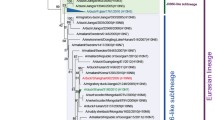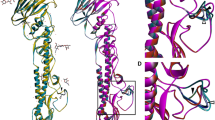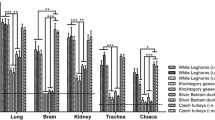Abstract
A comparative study of the ability of three low-pathogenic avian influenza virus (LPAIV) isolates to be transmitted from duck to duck was performed. Pekin ducks were inoculated with two LPAIV isolates from chickens (A/Ck/PA/13609/93 [H5N2], H5N2-Ck; A/Ck/TX/167280-4/02 [H5N3], H5N3-Ck) and one isolate from a wild bird (A/Mute Swan/ MI/451072/06 [H5N1], H5N1-WB). During the establishment of the passage model, only two viruses (H5N1, H5N2) were able to be transmitted from duck to duck. Transmission of these isolates was dependent on the inoculation dose and route of infection. Analysis of swab samples taken from ducks revealed that the wild-bird isolate, H5N1-WB, was primarily shed via the cloacal route. The chicken isolate, H5N2-Ck, was isolated from cloacal as well as oro-pharyngeal swabs. Analysis of the amino acid sequences of the viral surface glycoproteins showed that the hemagglutinin (HA) of the H5N2-Ck isolate was under a stronger evolutionary pressure than the HA of the H5N1-WB isolate, as indicated by the presence of a larger number of amino acid changes observed during passage. The neuraminidase (NA) of both viruses showed either no (in the case of H5N1-WB) or very few amino acid changes.









Similar content being viewed by others
References
Achenbach JE, Bowen RA (2011) Transmission of avian influenza A viruses among species in an artificial barnyard. PLoS One 6(3):e17643
Banks J, Speidel ES, Moore E, Plowright L, Piccirillo A, Capua I, Cordioli P, Fioretti A, Alexander DJ (2001) Changes in the haemagglutinin and the neuraminidase genes prior to the emergence of highly pathogenic H7N1 avian influenza viruses in Italy. Arch Virol 146:963–973
Bosch FX, Orlich M, Klenk H-D, Rott R (1979) The structure of the hemagglutinin, a determinant for the pathogenicity of influenza viruses. Virology 95:197–207
Campitelli L, Mogavero E, De Marco MA, Delogu M, Puzelli S, Frezza F, Facchini M, Chiapponi C, Foni E, Cordioli P, Webby R, Barigazzi G, Webster RG, Donatelli I (2004) Interspecies transmission of an H7N3 influenza virus from wild birds to intensively reared domestic poultry in Italy. Virology 323:24–36
Dlugolenski D, Jones L, Saavedra G, Tompkins SM, Tripp RA, Mundt E (2011) Passage of low-pathogenic avian influenza (LPAI) viruses mediates rapid genetic adaptation of a wild-bird isolate in poultry. Arch Virol 156:565–576
Fouchier RA, Munster V, Wallensten A, Bestebroer TM, Herfst S, Smith D, Rimmelzwaan GF, Olsen B, Osterhaus AD (2005) Characterization of a novel influenza A virus hemagglutinin subtype (H16) obtained from black-headed gulls. J Virol 79:2814–2822
Gay L, Mundt E (2010) Testing of a new disinfectant process for poultry viruses. Avian Dis 54(1 Suppl):763–767
Gohrbandt S, Veits J, Breithaupt A, Hundt J, Teifke JP, Stech O, Mettenleiter TC, Stech J (2011) H9 avian influenza reassortant with engineered polybasic cleavage site displays a highly pathogenic phenotype in chicken. J Gen Virol 92:1843–1853
Ha Y, Stevens DJ, Skehel JJ, Wiley DC (2002) H5 avian and H9 swine influenza virus haemagglutinin structures: possible origin of influenza subtypes. EMBO J 21:865–875
Hinshaw VS, Air GM, Gibbs AJ, Graves L, Prescott B, Karunakaran D (1982) Antigenic and genetic characterization of a novel hemagglutinin subtype of influenza A viruses from gulls. J Virol 42:865–872
Hoffmann TW, Munier S, Larcher T, Soubieux D, Ledevin M, Esnault E, Tourdes A, Croville G, Guérin JL, Quéré P, Volmer R, Naffakh N, Marc D (2012) Length variations in the NA stalk of an H7N1 influenza virus have opposite effects on viral excretion in chickens and ducks. J Virol 86:584–588
Kawaoka Y, Yamnikova S, Chambers TM, Lvov DK, Webster RG (1990) Molecular characterization of a new hemagglutinin, subtype H14, of influenza A virus. Virology 179:759–767
Lee CW, Swayne DE, Linares JA, Senne DA, Suarez DL (2005) H5N2 avian influenza outbreak in Texas in 2004: the first highly pathogenic strain in the United States in 20 years? J Virol 79:11412–11421
Li SQ, Orlich M, Rott R (1990) Generation of seal influenza virus variants pathogenic for chickens, because of hemagglutinin cleavage site changes. J Virol 64:3297–3303
Monteith HD, Shannon EE, Derbyshire JB (1986) The inactivation of a bovine enterovirus and a bovine parvovirus in cattle manure by anaerobic digestion, heat treatment, gamma irradiation, ensilage and composting. J Hyg 97:175–184
Mundt E, Gay L, Jones L, Saavedra G, Tompkins SM, Tripp RA (2009) Replication and pathogenesis associated with H5N1, H5N2, and H5N3 low-pathogenic avian influenza virus infection in chickens and ducks. Arch Virol 154:1241–1248
OIE, 2006 (http://www.oie.int/eng/normes/mmanual/A_00037.htm)
Pantin-Jackwood MJ, Miller PJ, Spackman E, Swayne D, Susta L, Costa-Hurtado M, Suarez D (2014) Role of poultry in the spread of novel H7N9 influenza virus in China. J Virol 88:5381–5390
Pillai SP, Pantin-Jackwood M, Suarez DL, Saif YM, Lee CW (2010) Pathobiological characterization of low-pathogenicity H5 avian influenza viruses of diverse origins in chickens, ducks and turkeys. Arch Virol 155:1439–1451
Reed LJ, Muench H (1938) A simple method of estimating fifty per cent endpoints. Am J Epidem 27:493–497
Rohm C, Zhou N, Suss J, Mackenzie J, Webster RG (1996) Characterization of a novel influenza hemagglutinin, H15: criteria for determination of influenza A subtypes. Virology 217:508–516
Shinya K, Makino A, Hatta M, Watanabe S, Kim JH, Kawaoka Y (2010) A mutation in H5 haemagglutinin that conferred human receptor recognition is not maintained stably during duck passage. J Gen Virol 91:1461–1463
Slemons RD, Easterday BC (1977) Type-A influenza viruses in the feces of migratory waterfowl. J Am Vet Med Assoc 171:947–948
Slemons RD, Johnson DC, Osborn JS, Hayes F (1974) Type-A influenza viruses isolated from wild free-flying ducks in California. Avian Dis 18:119–124
Sorrell EM, Perez DR (2007) Adaptation of influenza A/Mallard/Potsdam/178-4/83 H2N2 virus in Japanese quail leads to infection and transmission in chickens. Avian Dis 51(1 Suppl):264–268
Sorrell EM, Song H, Pena L, Perez DR (2010) A 27-amino-acid deletion in the neuraminidase stalk supports replication of an avian H2N2 influenza A virus in the respiratory tract of chickens. J Virol 84:11831–11840
Spackman E, Gelb J Jr, Preskenis LA, Ladman BS, Pope CR, Pantin-Jackwood MJ, McKinley ET (2010) The pathogenesis of low pathogenicity H7 avian influenza viruses in chickens, ducks and turkeys. Virol J 19(7):331
Spackman E, Senne DA, Myers TJ, Bulaga LL, Garber LP, Perdue ML, Lohman K, Daum LT, Suarez DL (2002) Development of a Real-Time Reverse Transcriptase PCR Assay for Type A Influenza Virus and the Avian H5 and H7 Hemagglutinin Subtypes. J Clin Microbiol 40:3256–3260
Spackman E, Swayne DE, Suarez DL, Senne DA, Pedersen JC, Killian ML, Pasick J, Handel K, Pillai SP, Lee CW, Stallknecht D, Slemons R, Ip HS, Deliberto T (2007) Characterization of Low-Pathogenicity H5N1 Avian Influenza Viruses from North America. J Virol 81:11612–11619
Stallknecht DE, Shane SM (1988) Host range of avian influenza virus in free-living birds. Vet Res Commun 12:125–141
Stech O, Veits J, Weber S, Deckers D, Schröer D, Vahlenkamp TW, Breithaupt A, Teifke J, Mettenleiter TC, Stech J (2009) Acquisition of a polybasic hemagglutinin cleavage site by a low-pathogenic avian influenza virus is not sufficient for immediate transformation into a highly pathogenic strain. J Virol 83:5864–5868
Stevens J, Blixt O, Tumpey TM, Taubenberger JK, Paulson JC, Wilson IA (2006) Structure and receptor specificity of the hemagglutinin from an H5N1 influenza virus. Science 312:404–410
Tong S, Li Y, Rivailler P, Conrardy C, Castillo DA, Chen LM, Recuenco S, Ellison JA, Davis CT, York IA, Turmelle AS, Moran D, Rogers S, Shi M, Tao Y, Weil MR, Tang K, Rowe LA, Sammons S, Xu X, Frace M, Lindblade KA, Cox NJ, Anderson LJ, Rupprecht CE, Donis RO (2012) A distinct lineage of influenza A virus from bats. Proc Natl Acad Sci USA 109:4269–4274
Tong S, Zhu X, Li Y, Shi M, Zhang J, Bourgeois M, Yang H, Chen X, Recuenco S, Gomez J, Chen LM, Johnson A, Tao Y, Dreyfus C, Yu W, McBride R, Carney PJ, Gilbert AT, Chang J, Guo Z, Davis CT, Paulson JC, Stevens J, Rupprecht CE, Holmes EC, Wilson IA, Donis RO (2013) New world bats harbor diverse influenza A viruses. PLoS Pathog 9:e1003657
Tsan-Yuk Lam T, Wang J, Shen Y, Zhou B, Duan L, Cheung C-L, Ma C, Leung C, Chen X, Li L, Hong W, Chai Y, Zhou L, Liang H, Ou Z, Liu Y, Faroogui A, Klevin D, Poon LL, Smith DK, Pybus OG, Leung GM, Shu Y, Webster RG, Webby RJ, Peiris JS, Rambaut A, Zhu H, Guan Y (2013) The genesis and source of the H7N9 influenza viruses causing human infections in China. Nature 502:241–244
Veits J, Weber S, Stech O, Breithaupt A, Gräber M, Gohrbandt S, Bogs J, Hundt J, Teifke JP, Mettenleiter TC, Stech J (2012) Avian influenza virus hemagglutinins H2, H4, H8, and H14 support a highly pathogenic phenotype. Proc Natl Acad Sci USA 109:2579–2584
Webster RG, Bean WJ, Gorman OT, Chambers TM, Kawaoka Y (1992) Evolution and ecology of influenza A viruses. Microbiol Rev 56:152–179
Webster RG, Rott R (1987) Influenza virus A pathogenicity: the pivotal role of hemagglutinin. Cell 50:665–666
Author information
Authors and Affiliations
Corresponding author
Rights and permissions
About this article
Cite this article
Ridenour, C., Williams, S.M., Jones, L. et al. Serial passage in ducks of a low-pathogenic avian influenza virus isolated from a chicken reveals a high mutation rate in the hemagglutinin that is likely due to selection in the host. Arch Virol 160, 2455–2470 (2015). https://doi.org/10.1007/s00705-015-2504-1
Received:
Accepted:
Published:
Issue Date:
DOI: https://doi.org/10.1007/s00705-015-2504-1




